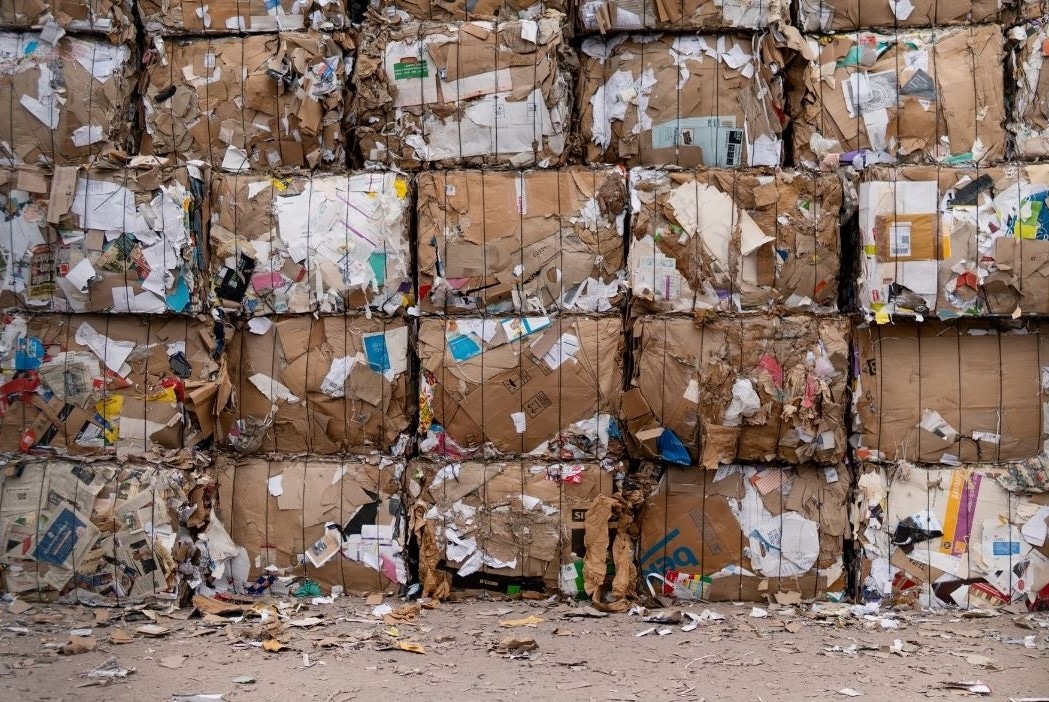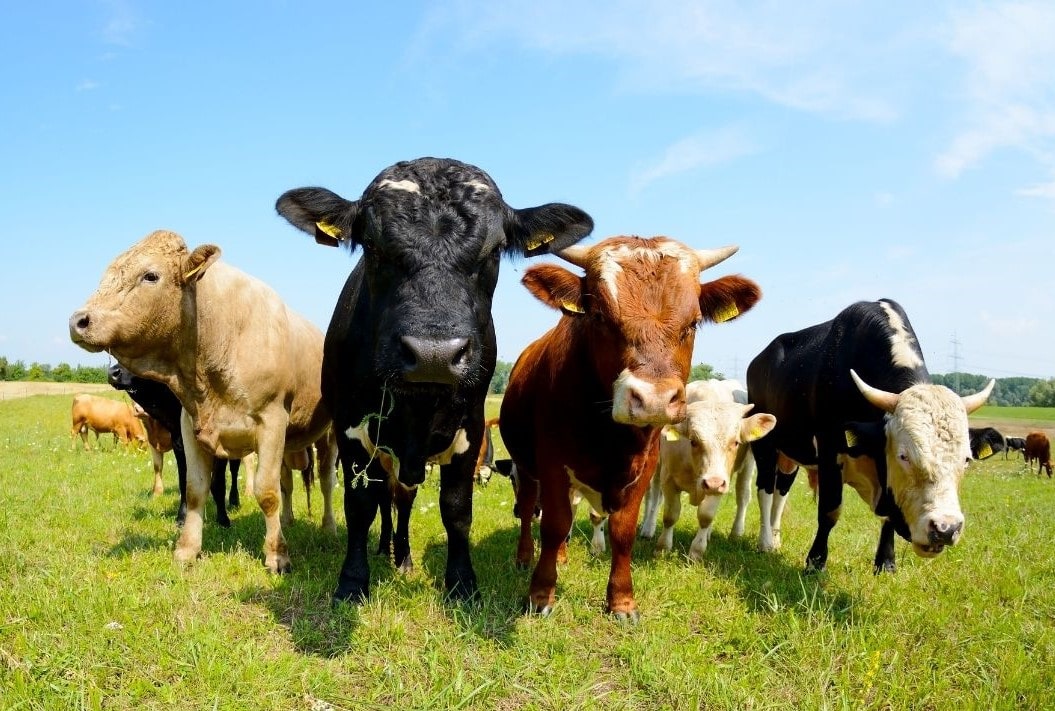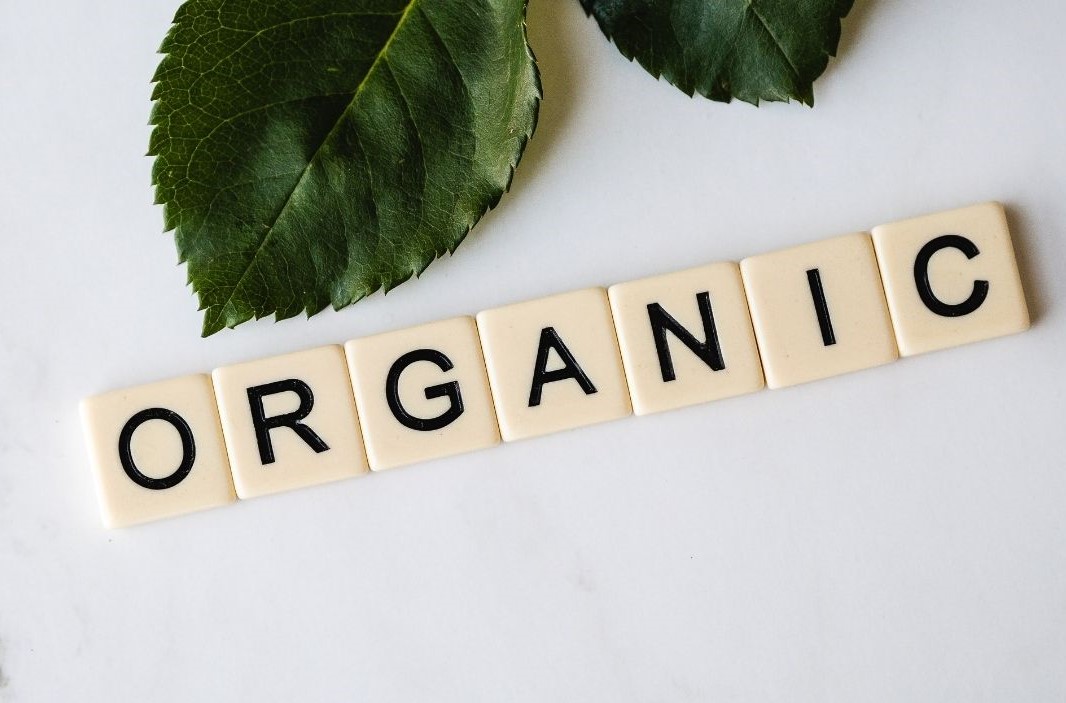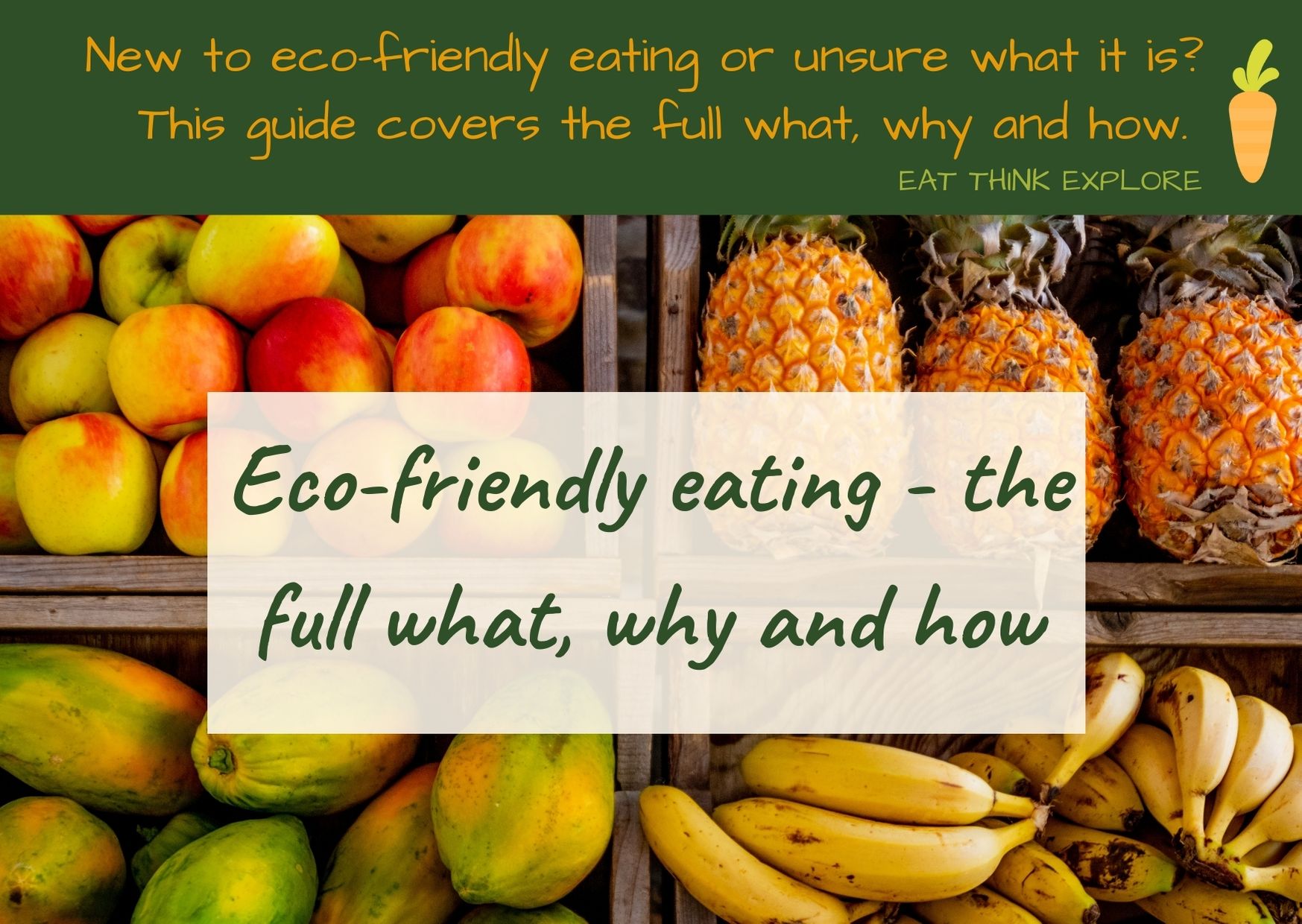New to eco-friendly eating or unsure what it is? This guide covers the full what, why and how of eating in a way that is better for the planet, and happens to be better for you too!
What is eco-friendly eating?
It’s simple, this is eating in a way that reduces our impact on the planet. The end goal is to be eating in a way that is sustainable, that is, that can be continued forever in the same form because it causes little or no damage to the environment.
I’m not going to lie, to live in a way that has no impact is incredibly hard and just not realistic for most of us. It’s also off putting as the effort to be eco-friendly is often seen as too high to bother starting. It’s important to realise that you do not have to be perfect! Every better choice has an impact, and the more of us doing it, the better chance we have of keeping our planet in working order.
The principles I try to follow are these:
Make the simple swaps, things like using your own bags, taking a reusable water bottle. To not do these things is quite frankly lazy. If you won’t put yourself out by even a tiny bit to make a difference then you’re in the wrong place on this blog post!
Try to make at least one better choice every day. If you can make more then great.
The eco friendly options often require some up front cash, but generally save you money in the long run as you’re not buying products. So get them one at a time, and you may even find they’re funding themselves with your savings.
Try and bring in the harder swaps one at a time. Find what you need, look up local alternatives, and figure out the best way to introduce this into your life. Once it’s in, move to the next change.
Don’t worry about strict rules, educate yourself about what’s in your food and where it comes from so you can make educated choices about what you can do in the moment. It’s ok to eat something non sustainable sometimes, especially if it’s something really good for you…
What are the benefits of eco-friendly eating?
What’s interesting is that eating in a way that’s better for the planet, is often same thing that’s best for you. It’s almost like Mother Nature knows what she’s on about!

There are so many ways that eating like this benefits us, some of which are:
We help preserve the world as a system. Not only is keeping our world wild and biodiverse good for the animals that live in it, it’s also essential for humans as a species if we want to continue with life as we know it. Our water stability, climate control and food production depend on it. Read more here…
Home grown or locally sourced foods have travelled less distance and are likely to be fresher. Vitamins degrade over time so by eating these local foods, you’re putting more nutrients into your body, especially if you can grow your own. As a society we are deficient in many vitamins as we consume so many nutrient poor foods. This is why we’re getting sicker as a population despite being ‘more advanced.’
Organic soils are less likely to be exhausted (low in minerals and organic matter) so organic foods will naturally contain more minerals and come with less toxic residues from pesticides and fertilisers. A double win for us and biodiversity!
Eating seasonally available foods means we get eat a wider range of foods throughout the year, increasing our variety of vitamins and minerals and reducing the chances of developing an intolerance. We also find that the foods often contain what we need, antioxidant rich foods in summer to protect us from sun damage, foods high in vitamin C before the winter sickness season. We’re always overriding a finely balanced system that’s evolved over centuries because we think we know better. We really don’t!
Packaging and processing use chemicals which can end up in our foods, some are already being linked to diseases like cancer. Keep yourself safe by avoiding them and eating natural.
Whilst what you eat impacts far more than just your waistline, eating eco-friendly foods will help you lose weight as you can’t really overeat vegetables. Fill yourself right up and enjoy losing weight.
What do we need to think about when making sustainable food choices?
I’m not going to lie, there is a lot to think about and it can seem very overwhelming! The key here is to not let this paralyse you from action. Yes, it’s so hard to know all the answers to these questions for every piece of food you consume, but that would be perfection and that’s not what we should be aiming for.
Instead, read these to educate yourself and start asking these questions when thinking about food, but allow yourself to be imperfect at this and just make small simple changes, a step forward each day.
Start with the things you can do easily, like reducing the packaging you can see on products, choosing a sustainable supermarket, eating more plants and moving to local grass fed organic meats. The great thing is that you will actually be leading a healthier lifestyle when you start doing this so you get double benefits!
And remember, this is what I’m here for – here at Eat Think Explore I will research these things and share it so you don’t have to!
Here are the main considerations…
How was it grown?
What chemicals were required to grow it? Fertilisers, pesticides, antibiotics or hormones
Are the soils it’s being grown in being depleted of minerals and microbes? This makes it harder to grow nutrition dense foods without large levels of chemicals and destroys biodiversity, leading to soil exhaustion.
Are the locals that grow it treated fairly or exploited?
Are the animals treated well?


How many resources did it take to produce?
Meat takes a lot more resource to grow than plants. That’s just how food chains work, a lot more land is required to support a predator, which is why there are less of them. Simple ecology.
How much water was required for production? Is the area it’s growing in short of water, or is this production diverting water flows from rivers and natural wetlands?
Processed foods often require heat, chemicals and water to produce and the packaging itself requires resources and production energy.
Where did the land come from?
Is this product contributing to deforestation or loss of habitat?


How far has it travelled / where was it grown?
Every mile contributes to its carbon footprint and emissions.
What is the processing like?
Some foods require significant processing to bring them to the state they are on our supermarket shelves. This can require heat, power, chemicals and water, significantly increasing their carbon footprint, emissions and pollution levels.


How is it packaged?
Is it packaged? Any packaging, even biodegradable still has a footprint.
Is it in packaging that cannot be recycled and will therefore exist pretty much forever?
How is it shipped?
Even if the packaging around the product on the shelves is recyclable and minimised, how is it shipped? Often products are heavily packaged during shipping and this is probably not recyclable or reused.


What about the food it was fed?
When we’re thinking about meat, we can think about where it has lived and feel that it’s sustainable because it lives on UK soils and is from a local farm. But what has it been fed? A lot of the soya feed used for cattle comes from areas in Brazil and is responsible for habitat loss.
How can we be more eco-friendly in our food choices?
With so many things to take in mind above, there are many things we can do. Some, unfortunately, require some research as they are not immediately visible when in the supermarket.
There are loads of things you can do that are super easy and obvious though, so don’t let that stop you from making some changes. Moving to an eco friendly lifestyle is not even a marathon or a sprint, it’s a journey. The quicker we can take it the better, but the important thing is just to keep moving forwards and putting one foot in front of the other.
I’ve listed these from easiest to hardest, so if you’re starting to feel overwhelmed, pick a couple of easy ones to work on, and come back to this article another day. You can’t put all this into action at once!
Take your own bags shopping
We’ve all heard it, but seriously, buy some eco-friendly fabric shopping bags or reuse the plastic bags you already have. Put some in your car, stuff one in your handbag, put them by the door with your keys so you take them with you! There are no excuses for not doing this one most of the time!
Also, it’s easy to think that paper bags are a better choice, and in terms of future pollution, they are, but they still cause millions of trees to be cut down each year and more resources are required to make a paper bag than a plastic one so taking your own is always best…

Use your own produce bags
Again, so simple this one, take some smaller bags, or buy some mesh produce bags (from eco friendly materials) and pick your fruit and veg loose from the supermarket and put them in your bags.
Again, some have paper or even compostable produce bags now, but they still require resources to create even if they will decompose…
Use pots that fit the heat rings on your cooker
If your pot is too small for the heat ring, the heat goes straight up and into the air i.e. it’s totally wasted. Use the correct sized pot and know you are doing your bit!
Only buy plastic water bottles when absolutely necessary
Another simple one. Carry your own plastic bottle with you and drink tap water (if it’s safe). If you really hate the taste then filter it first.
Not only will this save a ridiculous amount of water bottles from being produced, it’ll mean you always have water on you so can stay hydrated, keeping your energy levels up all day.
There are many places to fill these up now, many airports have water fountains, and most cafes, restaurants, pubs etc will fill your bottle up with tap water if you ask nicely.
If you get caught short when you’re out (it happens!) and have to buy a bottle of water, make sure that it ends up in recycling, not in the landfill bins. Yes, this may mean you have to carry it home with you…

Avoid unnecessary packaging
Choose the option with the least packaging. Rather than just grabbing the brand you always pick, have a look up and down the aisle, are there other companies making the same thing but with better packaging. Could you buy your mayonnaise in glass rather than plastic? Or buy a larger version so that you’ll use less plastic for the same volume of ketchup (this only works for things that will last long enough for you to use it)?
Always choose the loose fruit and veg.
Can you get your fish, ham, cheese etc from the deli counters and take your own plastic box to bring it home in (avoiding the packaging). There are many butchers and supermarkets starting to allow this now. It often costs a little more, but it is usually better quality too…
One of my pet hates is the wrap they put around multipacks, which is very rarely recyclable. Like around tins of beans, or multipacks of tissues. Avoid it!
Packaging types to really try to avoid are the non-recyclable ones like polystyrene (a suspected carcinogen) and black plastic.
Eat more fruit and vegetables
We should aim for 2/3 of our plate to be fruits and veg. Not only is this giving your body what it needs, the environmental impact of producing the vegetables is much lower than meat and processed grains like pasta.
For a lot of you this is likely to be a big change (as a nation we do NOT hit our 5 a day target), so start smaller and go for 1/3 of the plate if you eat few veg at the moment. If you’re not a fan of vegetables then find ways to make them taste good. The standard boiled veg for example taste bland and have actually lost a lot of their nutrients to the water. No good. Instead, steam, roast (really makes most taste amazing!), or steam fry and mix with flavoursome sauces. Experiment with spices like paprika, chipotle chilli, curry powders, cumin, garlic or herbs like rosemary and thyme until you find some that you like. And cut the veg small. That’s how I went from being a veggie hater to loving pretty much all of them. It’s amazing how your palette adjusts!
Just by eating more vegetables and fruit, this should have the effect of reducing the meat and processed foods you eat without you thinking about it.

Reduce meat (especially beef) and dairy
Industrially farmed meat and dairy have the largest impact of any food product. By a looong way when it comes to beef and dairy. Make beef a rare treat, switch milk to plant-based milks where possible and minimise other meats and cheese in favour of beans and legumes. Or reduce the portions of meat that you consume.
Start with one dairy and meat free meal a week and see where you go. My husband always said that he could never give up meat, but we’ve found that some of our vegetarian and vegan meals are so good we really don’t mind.
Note, I’m not saying that I think we all need to give up meat forever. But limit it, and get it from good sources (locally farmed, grass fed organic beef – yes it’s pricey but that makes it a proper treat).
Choose fish which are from sustainable sources
The MSC is a good brand to look for (Marine Stewardship Council). It’s like a badge of sustainability. Pole and line caught tuna fish also means that the nets that catch all sorts of large marine life like dolphins haven’t been used. Vary up your fish and try some of the odd ones that you’ve not heard of before rather than always going for the same species like cod, salmon and haddock.
Wild caught does not mean eco-friendly. Farmed also does not mean eco-friendly as poorly managed farms are massive producers of methane.
Fish caught more locally to our shores are also more likely to have been caught in compliance with laws and have travelled less distance.
Oh, and another thing, buy your tuna tins separately – not in the multipacks which are wrapped in that horrid unrecyclable wrap.

Choose to shop at a sustainable supermarket
Not all the supermarkets are equal. Choose one which has shown that they care for the planet in their practices and policies. I’m talking things like energy efficient fridge doors, reduction of packaging on own brand products, using renewable energy sources and sourcing foods responsibly.
Check out my article on the most sustainable supermarkets to see which ones rank highest in the UK as this is all not obvious from in store…
Cook double batches
When cooking, make enough for another night. This saves energy (both gas/electric and your own!) compared to cooking twice. Freeze it for another week, or even better, have it for dinner a couple of days later.

Don’t buy anything with palm oil in it that’s not from a sustainable source
You don’t have to avoid palm oil altogether. Some of the alternatives are just as bad, they just haven’t hit the headlines yet. Instead choose products with palm oil from a sustainable source – they’ll say if they are on the labels/ingredients list.
Buy local
Take advantage of local farmers markets for vegetables and meats that will not have travelled far, reducing their carbon footprint. These are often loose too, saving extra packaging.
Reduce food waste
We throw so much food away in the UK and US. Often this is because we bin foods on the best before date, or don’t use it in time because we didn’t really have a plan.
A best before date is just that – it’s better before that date, but it’s fine to eat after – it won’t harm you.
Foods with a use by date should be eaten by that date, especially meats. There are things like yoghurt and milk which often last beyond this date and you can easily tell if they’re off by the smell not the date.
Plan your meals. This really helps to reduce waste, as you only buy what you are going to use, and you can plan to eat up the whole packet of something. It has the added benefit of generally leading to you making healthier choices for dinner rather than making them on impulse when you’re more likely to go for something gratifying or choose take out.
Get creative with your leftovers, or just keep them to eat alongside lunch or mix in with another dinner. Why throw away good food? Most things last in the fridge for a couple of days sealed in a box.
If you struggle with meal planning, come check out my meal planning solution – nutritionally balanced, planet-friendly recipes in a meal planning software with suggested meal plans to make this super easy for you – all for less than a coffee and a cake! Read more here…

Get your meat from a source that prioritises animal welfare and the environment
Not always easy to see, especially in supermarkets, but grass fed and organic are good places to start. Always pick free range chickens and eggs if you care about animal welfare.
Reduce kitchen waste
Replace paper towels and napkins with cloths (microfibre are superabsorbent and don’t break).
Compost food scraps if you have the space and are growing any kind of plants.
Don’t use single use plates and cutlery. If you’re worried about them breaking in the garden invest in some recycled plastic plates and cutlery that will last.
Buy organic
Organic foods should be grown without the need for synthetic pesticides. Organic farms recycle resources and promote biodiversity. Soils retain microbes and organic matter and have the chance to regain minerals. As there are less pesticides, you aren’t ingesting chemicals either. Their downside is the price…
If you’re new to this then go for the ones that you don’t peel so that you get the maximum benefit from the pesticide avoidance i.e. broccoli, cauliflower, beans, leafy veg, apples, pears. Limit your organic to the ones that bring the biggest benefit.
Organic meats are those which have access to the outdoors (rather than the majority of beef which is kept inside for the majority of its life). Pasture raised livestock have less of a negative impact on the environment. They cannot be supplemented with growth hormones or antibiotics. Which is great as we don’t want those in our bodies either.
Even organic milk has benefits for your health, as dairy cattle are often pumped full of artificial hormones to increase their milk production. Our hormones are finely balanced – we don’t want to mess with them!

Reduce processed foods
Processed foods like crisps, chocolate, pastas, jarred sauces, cakes, ready meals, cereals and snack bars are a major contributor to the packaging problem as their packaging is rarely recyclable, and they are rarely good for us. Why would we eat these things!!? Well ok, they taste good. But you may find as you switch off them to more fruit-based snacks and desserts, that you start to lose that sweet tooth and realise that a lot of it is just flavoured cardboard. That’s what’s starting to happen for us….
If you must have something sweet try doing some healthy baking once a week so you can get something sweet if you need it. There are so many healthy baking recipes out there (I have a few!), try some until you find one that works for you.
Cook from scratch. It seems harder than using a jar sauce, but seriously, making a tomato sauce for pasta from scratch is sooo easy, and you won’t be eating the sugars and chemicals they stuff in jarred sauces.
Get into more natural flavours. People often think that healthy foods are bland, but get friendly with your spice rack and experiment with chipotle chilli, smoked paprika, garlic, tamari and so many other herbs and spices. You’ll find new tastes to replace the salt and fat and herbs and spices actually have health benefits!
Eat your veg in a more raw format
Some veg have more nutrients cooked (spinach and tomatoes being examples), but most are better for you raw. Cook your veg for less time or eat them raw and save the cooking energy.

Find your local packaging free store
There are stores popping up all over that allow you to buy dried foods like pastas, grains and nuts in your own container and in the quantity that you need. Yes, it’s an extra trip to a different shop, but if you have the space for some larger containers, you don’t need to go very often to top up.
A quick google search should help you to find your nearest. It’s worth it to avoid all the totally unrecyclable pasta, rice and nut bags – think how many of them you get through in a year!
Buy foods which have travelled less distance
It always amazes me how far our food travels. That we use beef from Brazil, bananas and pineapples from Central America and our coffee and chocolate from Africa.
It’s easy to think that our fruits and vegetables are available all year round because they are in the shops, but if you read the labels to see where the fruit is from, it varies a lot! In the summer our strawberries are from the UK, just before that from Spain. Blueberries in the winter come from places like Peru!
Not so easy this one as it complicates meal planning and it’s hard to know with more processed foods where any of it is from, hence it’s near the bottom of the list (again, giving up processed foods and cooking from raw ingredients helps here). Check online for seasonal veg lists and vary your food up throughout the year. To be perfect here would really limit flavour in terms of spices and things so a lot of this comes down to better choices. Is there an alternative that hasn’t travelled as far i.e. switching berries in winter for apples and pears, or courgettes for cabbages in autumn and winter? Can you do without it?

Preserve foods
If you want berries all year round, get locally grown ones in season and freeze them. Learn how to make jams and preserves so you can get the benefits of fruits and veg all year.
Be thoughtful when you eat out
I’ve put this one low as eating out is a treat and so making sacrifices here will be hard, but here are some things you can do without running it…
Drink tap water not bottled.
Choose restaurants which use local ingredients.
Feel free to ask how the meat or fish was farmed – showing that we care is a great way to encourage them to change.
So how about it?
Got this far? I really hope you can see how important eco-friendly eating is to both our own health and for the world. I hope you can also see how you can make small changes that will have a far reaching positive impact!
If you need any help getting any of this implemented there are a few ways I can help:
Join my supportive Facebook community where you can take your first steps on this journey with others going through the same and my support.
If you struggle with meal planning, come check out my meal planning solution – nutritionally balanced, planet-friendly recipes in a meal planning software with suggested meal plans to make this super easy for you – all for less than a coffee and a cake!
If this all seems a bit overwhelming and like a lot to take on, or you’re still unsure how to get started, I’m happy to have a chat and help you get your thoughts in order – find a spot that fits in the link below…

